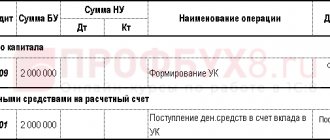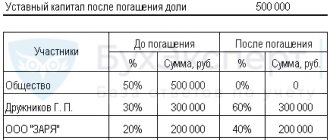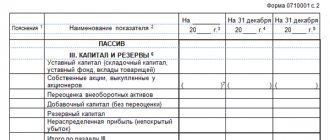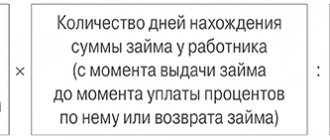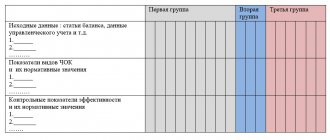Despite the fact that transactions accounting for authorized capital are rare, they are extremely important, as they reflect the relationship of the enterprise with its owners. Within the framework of this article, accounting entries associated with the initial formation of the authorized capital through contributions from its founders will be considered.
The property of an enterprise can be formed from its own and borrowed funds. Own funds (capital), in turn, consist of authorized capital, additional capital, reserve capital and retained earnings. The authorized capital occupies a central position among all the above reserves, since it is a fund formed when creating an enterprise. The first accounting entry at the enterprise is associated with the formation of the authorized capital - however, the authorized capital also applies to the last operations during the liquidation of the enterprise.
Accounting for authorized capital in the Chart of Accounts
Information about the state and movement of the authorized capital (share capital, authorized capital) of enterprises is reflected in passive account 80 “Authorized capital”.
The balance of this account must correspond to the size of the authorized capital recorded in the constituent documents of the enterprise. Entries in account 80 “Authorized capital” are made when forming the authorized capital, as well as in cases of increasing and decreasing capital, only after making appropriate changes to the constituent documents of the enterprise.
No other operations of the enterprise have an impact on the size of the authorized capital; the authorized capital changes only in cases and in the manner provided for by law or constituent documents.
Analytical accounting for account 80 “Authorized capital” should provide information on the founders of the enterprise, stages of capital formation (formation upon establishment and all subsequent changes) and types of shares (common and preferred shares).
Formation of authorized capital
After the state registration of the enterprise, the authorized capital in the amount of contributions of its founders is reflected in the credit of account 80 “Authorized capital” in correspondence with the debit of account 75 “Settlements with founders”, subaccount 75-1 “Settlements on contributions to the authorized (share) capital”.
Example 1
The amount of the authorized capital of CJSC Veter, according to the charter dated October 15, 2013, is 20 million rubles. According to the agreement on the establishment of JSC “Veter” dated October 15, 2013, shares were distributed among three founders:
– Tandem LLC – 10 million rubles;
– JSC “Beseda” – 5 million rubles;
– ZAO “Avalina” – 5 million rubles.
The date of state registration of JSC “Veter” is October 18, 2013.
| Contents of operation | Debit | Credit | Amount, rub. |
| 18.10.2013 | |||
| The management company was formed at the expense of a contribution from Tandem LLC | 75-1 | 80 | 10 000 000 |
| The management company was formed at the expense of a contribution from Beseda OJSC | 75-1 | 80 | 5 000 000 |
| The management company was formed at the expense of a contribution from ZAO Lavina | 75-1 | 80 | 5 000 000 |
The legislator has provided a certain period for payment of the authorized capital. Thus, according to the Law on JSC ( clause 1, article 34 ), at least 50% of the company’s shares distributed upon its establishment must be paid for within three months from the date of state registration of the company. Since, in accordance with paragraph 3 of Art. 2 of the Law on JSC, before payment of 50% of the company's shares distributed among its founders, the company does not have the right to enter into transactions not related to the establishment of the company, insofar as (if we return to the chronology of accounting records) the following transactions will be related to the payment of the authorized capital.
In relation to limited liability companies, the LLC Law establishes stricter time limits: the authorized capital must be paid by the founders in at least half at the time of state registration of the company ( Clause 2, Article 16 of the LLC Law ).
The maximum period for payment of the remaining part of the authorized capital in accordance with the Law on JSC and the Law on LLC is the same - one year from the date of state registration of the enterprise ( clause 1, article 34 of the Law on JSC and clause 1, article 16 of the Law on LLC ).
Payment of authorized capital
The actual receipt of deposits of the founders is recorded in accounting entries in the debit of the accounts for accounting of valuables and the credit of account 75 “Settlements with founders”. In accordance with paragraph 2 of Art. 34 of the Law on JSC , payment for shares distributed among the founders of the company upon its establishment, additional shares placed by subscription, can be made in money, securities, other things or property rights or other rights that have a monetary value.
A similar rule is contained in paragraph 1 of Art. 15 the LLC Law . If the founder makes a contribution in Russian rubles, then no special features arise in accounting, but the receipt of contributions in the form of other material assets and rights deserves special attention.
The Law on JSC ( Clause 3, Article 34 ) and the Law on LLC ( Clause 2, Article 15 ) establish special requirements that the capitalization of property transferred in kind to the ownership of the enterprise on account of contributions to the authorized capital is carried out at market prices. In this case, the monetary valuation of the contributed property is made by agreement between the founders .
The rules for capitalizing property into the authorized capital of LLCs and JSCs are presented in table form.
| Balance account | Contents of accounting legislation | Base |
| Debit of account 08 “Investments in non-current assets”. Then the received fixed assets and intangible assets are written off from the credit of account 08 to the debit of account 01 “Fixed assets” and (or) 04 “Intangible assets” in the generally established manner | The initial cost of fixed assets contributed as a contribution to the authorized (share) capital of an organization is recognized as their monetary value, agreed upon by the founders (participants) of the organization, unless otherwise provided by the legislation of the Russian Federation. The actual (initial) cost of an intangible asset contributed as a contribution to the authorized (share) capital is recognized as its monetary value agreed upon by the founders (participants) of the organization, unless otherwise provided by the legislation of the Russian Federation | Clause 9 PBU 6/01 “Accounting for fixed assets”6 Clause 11 PBU 14/2007 “Accounting for intangible assets”7 |
| Accounts for inventory and goods | The actual cost of inventories contributed as a contribution to the authorized (share) capital of the organization is determined based on their monetary value agreed upon by the founders (participants) of the organization, unless otherwise provided by the legislation of the Russian Federation | Clause 8 of PBU 5/01 “Accounting for inventories”8 |
| Account 58 “Financial investments” | The initial cost of financial investments made as a contribution to the authorized (share) capital of an organization is recognized as their monetary value, agreed upon by the founders (participants) of the organization, unless otherwise provided by the legislation of the Russian Federation | Clause 12 PBU 19/02 “Accounting for financial investments”9 |
The only exception to the rules is the contribution of an asset denominated in foreign currency to the authorized capital (see table below).
| Balance account | Contents of accounting legislation | Base |
| Account 52 “Currency accounts” | The value of an asset or liability expressed in a foreign currency is recalculated into rubles at the official exchange rate of this foreign currency to the ruble established by the Central Bank of the Russian Federation. If, for the recalculation of the value of an asset or liability expressed in foreign currency and payable in rubles, a different rate is established by law or by agreement of the parties, the recalculation is made at such rate. For accounting purposes, the specified conversion into rubles is made at the rate valid on the date of the transaction in foreign currency | Paragraphs 5 – 6 PBU 3/2006 “Accounting for assets and liabilities, the value of which is expressed in foreign currency”10 |
Example 2
Let's add data to example 1. The shares are distributed between three founders: Tandem LLC - 10 million rubles, Beseda OJSC - 5 million rubles, Lavina CJSC - 5 million rubles. Payment for shares on the basis of the agreement on the establishment of CJSC Veter is made in the following order. Tandem LLC contributes equipment at an agreed valuation of 4 million rubles, the right to use real estate for a period of five years at an agreed valuation of 3 million rubles. and cash – 3 million rubles. The other two founders must pay for the shares in cash.
The actual payment of the authorized capital took place:
– 10.22.2013 – the contribution of OJSC “Beseda” in the amount of 5 million rubles was fully paid;
– 10.24.2013 – property and rights were transferred as a contribution to Tandem LLC (equipment in the amount of 4 million rubles and the right to use property in the amount of 3 million rubles);
– 11/12/2013 – the contribution of CJSC “Avalina” in the amount of 5 million rubles was fully paid;
– November 13, 2013 – the contribution of Tandem LLC was paid in the amount of 3 million rubles.
The formation of the authorized capital of CJSC Veter is accompanied by the following transactions:
| Contents of operation | Debit | Credit | Amount, rub. |
| 22.10.2013 | |||
| Contribution was made in cash from Beseda OJSC | 51 | 75-1 | 5 000 000 |
| 24.10.2013 | |||
| Contribution made by Tandem LLC equipment | 08 | 75-1 | 4 000 000 |
| The right to use the property of Tandem LLC has been contributed | 97 | 75-1 | 3 000 000 |
| 12.11.2013 | |||
| A contribution was made in cash from Lavina CJSC | 51 | 75-1 | 5 000 000 |
| 13.11.2013 | |||
| A contribution was made in cash from Tandem LLC | 51 | 75-1 | 3 000 000 |
Taxation
The rules for taxation of contributions are specified in Letter of the Ministry of Finance No. 07-05-06/302 dated December 19, 2006.
Contributions to the management company do not form a tax base either for profit tax (clause 3, clause 1, article 251 of the Tax Code of the Russian Federation), or for value added tax (clause 4, clause 3, article 39 of the Tax Code of the Russian Federation).
In addition to money, the founders can contribute their share of the capital through property. In such cases, it is necessary to evaluate the property involved. If the value of the property share is more than 20,000.00 rubles, then for the assessment it is necessary to involve an independent expert and obtain a special opinion from him.
If the value of the property contribution is less than or equal to 20,000 rubles, then the monetary value of such OS is determined at the general meeting of the founders and is confirmed by a unanimous decision of all participants.
Making property investments does not create profit or loss either for the shareholder or for the issuer of shares or shares (clauses 1 and clauses 2 of clause 1 of Article 277 of the Tax Code of the Russian Federation).
The taxpayer receives property rights as payment for the shares provided to him, and the shareholder, in turn, transfers his property to receive certain shares of the issuer.
Thus, the calculated difference in the value of the contributed property and the nominal value of the share in the structure of the management company does not affect the taxable base for income tax.
A similar situation arises with the VAT taxation of property investments - the provision of property as a share of the management company is not considered a sale, and therefore is not subject to value added tax (clause 4, clause 3, article 39, clause 1, clause 2, article 146 Tax Code of the Russian Federation). At the same time, according to clause 11 of Art. 171 of the Tax Code of the Russian Federation, the issuing taxpayer has the right to deduct the VAT restored by the founder or shareholder.
When an accountant determines the property tax base for fixed assets accepted as an investment in the capital company, he must take into account the cost of such fixed assets according to accounting data (Letter of the Ministry of Finance No. 03-05-05-01/80 dated 03.10.2011). The property invested in the charter capital is accounted for at the cost reflected in the balance sheet in accordance with PBU.
Features of payment of authorized capital in foreign currency
The procedure for contributing foreign currency to the authorized capital is more specific. Russian enterprises do not have the right to make a contribution to the authorized capital in foreign currency, since this is prohibited by Art. 9 of the Federal Law of December 10, 2003 No. 173-FZ “On Currency Regulation and Currency Control” . As for foreign investors, according to Art. 6 of the Federal Law of July 9, 1999 No. 160-FZ “On Foreign Investments in the Russian Federation” they can make a contribution in foreign currency. In this case, the assessment of capital investment is carried out in the currency of the Russian Federation. The resulting exchange rate difference is subject to credit to the enterprise’s additional capital ( clause 14 of PBU 3/2006 ).
So, when making contributions in foreign currency to the authorized capital, the following accounting entries are made:
– Debit 75 “Settlements with founders” Credit 80 “Authorized capital” – formation of debt of a foreign founder at the agreed rate;
– Debit 52 “Currency accounts” Credit 75 “Settlements with founders” – receipt of foreign currency from a foreign founder at the rate on the date of crediting to the foreign currency account;
– Debit 75 “Settlements with founders” Credit 83 “Additional capital” – a reflection of a positive exchange rate difference (if the foreign currency exchange rate has increased) or Debit 83 “Additional capital” Credit 75 “Settlements with founders” - a reflection of a negative exchange rate difference (if if the exchange rate has fallen).
Since the newly created enterprise does not have a balance in account 83 “Additional capital,” a negative balance may arise in the passive account.
Example 3
The amount of the authorized capital of CJSC “Mart” according to the charter is
25 million rub. The shares are distributed between two shareholders: Raduga LLC - 20 million rubles, Soleil Ltd - 5 million rubles. According to the agreement on the formation of CJSC Mart dated November 6, 2013, Raduga LLC pays its share in rubles, and Soleil Ltd in US dollars (in the amount of $154,555.21).
The date of state registration of JSC “Mart” is November 11, 2013. Raduga LLC paid the capital on November 14, 2013, Soleil Ltd – on November 27, 2013.
US dollar exchange rate as of November 6, 2013 – 32.3509 rubles/dollar, as of November 27, 2013 – 32.9879 rubles/dollar.
The following entries will be made in the organization's accounting records:
| Contents of operation | Debit | Credit | Amount, rub. |
| 11.11.2013 | |||
| The management company was formed at the expense of the share of Raduga LLC | 75-1 | 80 | 20 000 000 |
| The management company was formed at the expense of the share of Soleil Ltd | 75-1 | 80 | 5 000 000 |
| 14.11.2013 | |||
| A contribution was made to the management company of CJSC Mart with funds from Raduga LLC | 75-1 | 80 | 5 000 000 |
| 27.11.2013 | |||
| A contribution was made to the management company of CJSC Mart in foreign currency Soleil Ltd ($154,555.21 × 32.9879 rubles/dollars) | 52 | 75-1 | 5 098 451,81 |
| Positive exchange rate difference reflected | 75-1 | 83 | 98 451,81 |
Placement of shares at a price above par
The formation of the authorized capital of a joint stock company may be accompanied by the formation of a premium amount per share. This amount arises in cases where, during the initial issue, shares are sold at a price higher than their nominal value. In accordance with the Instructions for the application of the Chart of Accounts, the amount of the difference between the sale and par value of shares, received in the process of forming the authorized capital of a joint-stock company (upon the establishment of a company, with a subsequent increase in the authorized capital), is credited to account 83 “Additional capital” in correspondence with account 75 "Settlements with founders." Since payment for the shares of a company upon its establishment is made by its founders at a price not lower than the nominal value of these shares ( Clause 1, Article 36 of the Law on JSC ), only a positive balance can be formed in account 83 “Additional capital”, but never a negative one.
If, according to current legislation, an LLC has an excess of the value of a participant’s contribution to the authorized capital of the company over the par value of the share paid by the participant, then the amount of such excess can be taken into account for the company’s accounting in the same manner as the amount of the difference between the sale and par value of the shares received in the process of forming the authorized capital of a joint-stock company ( Letter of the Ministry of Finance of Russia dated September 15, 2009 No. 03-03-06/1/582 ).
Example 4
According to the charter, the authorized capital of Volga OJSC is 25 million rubles. The nominal value of the shares is 1,000 rubles, 25,000 shares were issued. Shares are placed by private subscription at a price of RUB 1,050. Motor LLC buys 6,250 shares, Oka CJSC – 18,750 shares.
| Contents of operation | Debit | Credit | Amount, rub. |
| The management company was formed at the expense of a contribution from Motor LLC (6,250 × 1,000 rubles) | 75-1 | 80 | 6 250 000 |
| The management company was formed at the expense of a contribution from Oka CJSC (18,750 × 1,000 rubles) | 75-1 | 80 | 18 750 000 |
| Payment has been made to Motor LLC (6,250 × 1,050 rubles) | 51 | 75-1 | 6 562 500 |
| Payment has been made to ZAO Oka (18,750 × 1,050 rubles) | 51 | 75-1 | 19 687 500 |
| The difference between the sale and par value of shares acquired by Motor LLC is attributed | 75-1 | 83 | 312 500 |
| The difference between the sale and par value of shares acquired by Oka CJSC is attributed | 75-1 | 83 | 937 500 |
Legal regulation
The regulation of legal relations regarding deposits in the management company is carried out on the basis of the Civil Code of the Russian Federation (Article 51) and Federal Law No. 14-FZ of 02/08/1998.
14-FZ allows for an increase in the authorized capital by making additional contributions from the founders. The decision to make additional contributions must be notarized.
In addition to Federal Law No. 402 “On Accounting” dated December 6, 2011, accounting operations for making contributions during the development of organizations are regulated by the following regulations:
| PBU 9/99 | Order of the Ministry of Finance No. 32n dated 05/06/1999 |
| PBU 6/01 | Order of the Ministry of Finance No. 26n dated March 30, 2001 |
| PBU 10/99 | Order No. 33n dated 05/06/1999 |
| Chart of Accounts | Order No. 94n dated October 31, 2000 |
